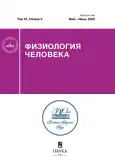Model of Contrast Sensitivity of the Human Visual System during Stimulus Movement
- Authors: Lyapunov S.I.1, Shoshina I.I.2, Lyapunov I.S.1
-
Affiliations:
- A.M. Prokhorov Institute of General Physics, RAS
- Saint Petersburg State University
- Issue: Vol 51, No 3 (2025)
- Pages: 90-97
- Section: ОБЗОРЫ
- URL: https://bakhtiniada.ru/0131-1646/article/view/305278
- DOI: https://doi.org/10.31857/S0131164625030091
- EDN: https://elibrary.ru/TQFITL
- ID: 305278
Cite item
Abstract
A model of contrast sensitivity of the human visual system when perceiving sinusoidal gratings moving at angular speeds of up to 1000 degrees per second is considered. The model is built on the basis of a tremor modulation signal, which is taken to be the difference in the concentration of the photoreagent at the extreme points of the tremor, normalized to the level of adaptation. The model details the dependence of contrast sensitivity on physiological factors such as photoreceptor size, amplitude and frequency of tremor for adaptation brightness of 0.001–1000 cd/m2. The model establishes a relationship between the results of measuring the contrast sensitivity of the visual system and the results of measuring natural tremor oscillations of the eyes during the perception of stationary and dynamic stimuli.
About the authors
S. I. Lyapunov
A.M. Prokhorov Institute of General Physics, RAS
Email: dc.cetsil@gmail.com
Moscow, Russia
I. I. Shoshina
Saint Petersburg State University
Email: shoshinaii@mail.ru
Russian Federation, St. Petersburg, Russia
I. S. Lyapunov
A.M. Prokhorov Institute of General Physics, RAS
Author for correspondence.
Email: dc.cetsil@gmail.com
Moscow, Russia
References
- Barr D.C., Ross J. Contrast sensitivity at high veloci-ties // Vision Res. 1982. V. 22. № 4. P. 479.
- Lyapunov S.I. Threshold contrast of the visual system as a function of the external conditions for various test stimuli // J. Opt. Technol. 2014. V. 81. № 6. P. 349.
- Lyapunov S.I. Visual-perception depth of field as a function of external conditions // J. Opt. Technol. 2017. V. 84. № 1. P. 16.
- Lyapunov S.I. Visual acuity and contrast sensitivity of the human visual system // J. Opt. Technol. 2017. V. 84. № 9. P. 613.
- Lyapunov S.I. Response of the visual system to sine waves under external conditions // J. Opt. Technol. 2018. V. 85. № 2. P. 100.
- Yarbus A.L. [The role of eye movements in the process of vision]. M.: Nauka, 1965. 166 p.
- Blackwell H.R. Contrast thresholds of the human eye // JOSA. 1946. V. 36. № 11. P. 624.
- Blackwell H.R. Neural theories of simple discrimination // JOSA. 1963. V. 53. № 1. P. 129.
- Campbell F.W., Gubisch R.W. Optical quality of the human eye // J. Physiol. 1966. V. 186. № 3. P. 558.
- Watson A.B. A formula for the mean human optical modulation transfer function as a function of pupil size // J. Vis. 2013. V. 13. № 6. P. 18.
- Savoy R., McCann J. Visibility of low-spatial-frequency sine-wave targets: Dependence on number of cycless // JOSA. 1975. V. 65. № 3. P. 343.
- Savoy R. Low spatial frequencies and low number of cycles at low luminances // Photogr. Sci. Eng. 1978. V. 22. № 2. P. 76.
- Altman Ya.A., Bigday E.V., Vartanyan I.A. et al. [Biophysics of sensory systems]. St. Petersburg: InformMed, 2007. 288 p.
- Lloyd J. [Fundamentals of Thermal Imaging]. Moscow: Mir, 1978. 414 p.
- Tarasov V.V., Yakushenkov V.G. [Infrared systems of the viewing type]. Moscow: Logos, 2004. 443 p.
- Schade О.H. Optical and photoelectric analog of the еуе // JOSA. 1956. V. 46. № 9. P. 721.
- Ostrovskaya M.A. [Frequency-contrast characteristics of the eye] // Optical-Mechanical Industry. 1969. № 2. P. 51.
- Eye Tracking: A Comprehensive Guide to Methods and Measures. Oxford University Press, 2011. P. 781.
- Barabanshchikov V.A. [Oculomotor structures of perception]. Moscow: Publishing house “Institute of Psychology of the Russian Academy of Sciences”, 1997. 384 р.
- Campbell F.W., Robson J.G. Application of Fourier analysis to the visibility of gratings // J. Physiol. 1968. V. 197. № 3. P. 551.
- Croner L.J., Kaplan E. Receptive fields of P and M ganglion cells across the primate retina // Vision Res. 1995. V. 35. № 1. P. 7.
- Freud E., Behrmann M., Snow J.C. What does dorsal cortex contribute to perception? // Open Mind (Camb). 2020. V. 4. P. 40.
- Kubarko A.I., Likhachev S.A., Kubarko N.P. Zrenie. Minsk: Bel. Gos. Med. Univ., 2009. V. 2. P. 352.
- Shoshina I.I., Kotova D.A., Zelenskaya I.S. et al. Contrast sensitivity and ocular microtremor: A model study of gravity effects on visual perception // Human Physiology. 2023. V. 49. № 7. P. 800.
- Kosikova A.V., Shoshina I.I., Lyapunov S.I. et al. [Characteristics of visual contrast sensitivity and ocular microtremor in schizophrenia] // Psychiatry (Moscow) (Psikhiatriya). 2024. V. 22. № 1. P. 58.
- Shoshina I., Kosikova A., Karlova A. et al. Optical registration of eye microtremor: Results and potential use // Proced. Comp. Sci. 2023. V. 225. P. 3832.
Supplementary files









